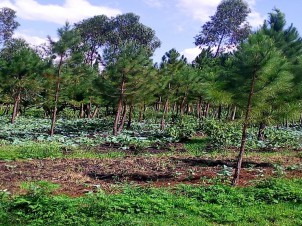Description de l'initiative
The Aturukuku River in Tororo Municipality is one of the key rivers that drain excess flood waters from the town centre. It provides fresh water to communities for drinking, washing and agriculture. The river was once surrounded with trees protecting the entire river catchment from the forces of erosion and landslides. However, the increased population in the Municipality has led to massive vegetation cover destruction with people searching for wood fuel, charcoal and land for cultivation and settlement. This has left the river catchment exposed to the forces of erosion and flooding, leaving thousands of people to cope with eroded farms lands and washed away bridges. This has not only destroyed household livelihoods but has also impacted the municipal council budget through higher infrastructure repair costs According to Municipal planners in 2011 about 250 households were destroyed at a cost of $ 150,000.
To tackle these challenges, the Tororo municipality council has designed and coordinated various interventions since 2014/2015; including:
- saving the River Aturukuku from erosion by encouraging tree and bamboo planting along the river bank:
- helping young people to diversify their income through fish farming along the river banks;
- promoting sustainable renewable energy technologies, especially biogas, in order to provide an alternative energy source and save the woodlots/forests.
The major beneficiaries of this project. River protection and environmental management: the municipality supplies the town with sustainable water flows and this supports an integrated approach to exploiting and preserving local natural assets, which benefits the entire community:
- Tree planting: beneficiaries are local investors who invest in the tree planting and local people who harvest tree branches and twigs for firewood and earn income from vegetable growing in the forest.
- Renewable energy technologies (biogas): Beneficiaries are young people who construct biogas plants and dairy farmers who save on charcoal and wood fuel costs by using biogas.
- Fish farming: beneficiaries are young people who earn from fish sales and reduce pressure on river bank through fish farming.
Activity and methodology. Tree planting: For an investor to obtain a piece of land along the river bank to plant trees, a formal request is sent to the Municipal Environmental Officer and through Council Resolution, the request is either passed or rejected. If the request is passed, the investor has to purchase tree seedlings (Either Pine or Eucalyptus) from a nursery bed dealer certified by the National Forest Authority.
Renewable Energy saving technology (Biogas technology): The uptake of this technology is dependent on a livestock-rearing farm’s ability to share costs with development partners and the availability of feed stock, especially cow dung, to feed the biogas plant. The Municipal Council authorities together with the development partners market the technology to the community and if the livestock-rearing farm can afford it, a certified Mason (builder) demarcates the plant site and construction is done. To help them sustain production farmers receive training and aftersales service from biogas technicians and support from Municipal Environmental Officers.
Fish farming: For a group of young people to obtain a piece of land for fish farming along the river bank, a formal request is sent to the Municipal Fisheries Officer for consideration and through Council Resolution, a request is either passed or rejected. If the request is passed, the group has to purchase the fingerlings from a certified fish farm. The group receives training in proper management and feeding techniques in order to ensure good productivity.
Principaux résultats obtenus
- Aturukuku River bank is protected from erosion through trees planted along the bank;
- Trees have contributed to mitigating climate change by absorbing carbon dioxide;
- Young persons income has been diversified and increased through fish farming, thus reducing pressure on river bank farming;
- 80% of the households with cattle have constructed biogas plants thus reducing the amount of firewood and charcoal, and thus the amount of CO2 released. This technology captures methane gas which is not only a greenhouse gas but ozone depleting. Instead it is used for cooking.


